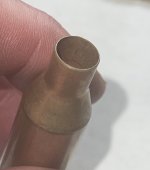I recently got myself an annealing setup to help extend my brass life and hopefully improve my velocity numbers. Prior to getting the annealer I've had a pretty solid load for my 300PRC with the 230 atip. The ADG brass I'm using probably had 5-6 firings on it and velocity would consistently average 2885 fps with high single digit SD performance.
I annealed my brass and loaded up 50 rounds exactly like I've always done. Running about 25 rds across the magneato speed I'm finding my average velocity is up to 2915 and SD has grown to the mid teens which I'm not happy with.
Is it normal to see a proven load increase velocity after annealing brass?
Apparently the annealing changed things just enough that I need to run another ladder test and tweak my load to hopefully get my consistency back?
I annealed my brass and loaded up 50 rounds exactly like I've always done. Running about 25 rds across the magneato speed I'm finding my average velocity is up to 2915 and SD has grown to the mid teens which I'm not happy with.
Is it normal to see a proven load increase velocity after annealing brass?
Apparently the annealing changed things just enough that I need to run another ladder test and tweak my load to hopefully get my consistency back?


